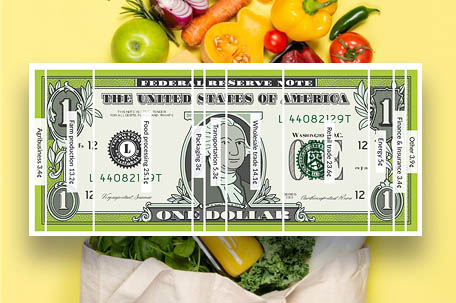
ABOVE PHOTO: The food dollar developed by the USDA Economic Research Service demonstrates how each part of the food supply chain contributes a portion to the food dollar.
BPT
The COVID-19 pandemic has affected food prices more than nearly any other part of the household budget. In April, the Food-at-Home Consumer Price Index increased 2.7%, which was the largest monthly jump since 1974. From June 2019 to June 2020, food prices are up 5.6%. Why is this happening, and furthermore, how can you save on your family’s grocery bills?
The food supply chain and price fluctuations
The food supply chain is made up of three parts: production, processing, and retail. As food items move down the supply chain, value is added to the product.
* Production incudes the farms and ranches that grow the food.
* Processing entails the manufacturers that turn food from the farm into consumer-ready options such as corn flakes or orange juice.
* Retail includes the stores where shoppers purchase different food items.
There are several factors that regularly influence food prices such as weather, farming production, growth in the population and trade. Sometimes there are shocks to the food supply chain that have big influences on prices, such as the COVID-19 pandemic.
COVID-19 factors’ influence on food prices
As communities quickly responded to the COVID-19 pandemic, every stage of the food supply chain saw costs increase. There are four key trends that are influencing food costs:
Shift to eating at home: In a matter of two months, approximately $23 billion in consumer spending away from home was redirected toward grocery stores as restaurants were forced to close due to COVID-19, according to FMI – The Food Industry Association.
Loss of foodservice demand: When restaurants closed, farmers and ranchers lost a key channel for their product. With fewer buyers, it is costly or impractical to harvest, preserve or store some food and beverage products.
Increasing production and processing costs: During COVID-19, companies have made investments and adjustments to safeguard their products and employees. This means costs for food production are higher. Some manufacturers have been able to innovate and find new markets for their products, but these changes often entail added costs.
Increasing operating costs for grocery stores: Compared to 2019, supermarket operating costs were up 7.9% in April 2020 and 6.7% in May 2020, according to USDA Economic Research Service. Grocery stores have remained open during the pandemic and have had to quickly adjust to new regulations, safety and sanitation practices and enhanced customer education – all requiring resources. In addition, some areas of the grocery store, including salad bars and hot bars, have had to shut down, meaning a loss of revenue.
For additional information, visit: www.FMI.org/FoodPrices101.
How you can save money at the grocery store
The experts at FMI – The Food Industry Association predict food prices may remain high for a while but stress the food supply chain is resilient and is likely to normalize over time. Regardless, there are ways shoppers can save money while at the store:
Plan ahead: Planning meals and snacks for the week before heading to the grocery store helps ensure you only purchase what you need. Use a shopping list or app to help stay organized. Check your store’s circular, website or app for coupons and specials ahead of time.
Compare options: Consider purchasing store brands, usually priced less and with equal taste and nutrition. When possible, purchase bulk protein options for freezing extras. Compare unit prices of different brands and package sizes to save. The “unit price” is the price per ounce, pound or pint, and is typically listed on the shelf tag. Canned or frozen food options can have an extended shelf-life and help stretch your dollar.
Seek out assistance programs: The Supplemental Nutrition Assistance Program (SNAP) and Women, Infants & Children nutrition program, or WIC, help families during times of need. Visit: Feeding Assistance.com for more information on these federal programs and eligibility.

















Leave a Comment